- Good Sam Community
- Everything RV
- Technical Issues
- Bent Main Frame Rail Below Slide - (Picture Heavy)
- Subscribe to RSS Feed
- Mark Topic as New
- Mark Topic as Read
- Float this Topic for Current User
- Bookmark
- Subscribe
- Mute
- Printer Friendly Page
Bent Main Frame Rail Below Slide - (Picture Heavy)
- Mark as New
- Bookmark
- Subscribe
- Mute
- Subscribe to RSS Feed
- Permalink
- Report Inappropriate Content
Feb-04-2017 07:18 AM
I’m inquiring if you or someone you know has run into where the main frame rail (thin I beam style) bent down behind the rear spring hanger and if you know any of the details surrounding it? This is a somewhat technical & long post by it's nature and I will try to keep it short as I can and use pictures get the point across. I have searched the web for this type of failure and to date have not found this type of issue. I have found a lot of bent A Frames, spring hangers and I beam web cracks. Mine is different. I did find one where the frame did failed in a similar manner and it was here on RV.net. See here. Bent Frame and breaks However in this case, the camper was in an accident where the camper become air born, dropped down hard on the road and bent the frame rail in one very large event.
Background: This past fall on our last campout, our slide room would no longer retract without heavily binding on the top rear and lower front sides of the slide. This issue has been ongoing for several years and has progressed worse over time. Basically, the slide opening in the camper wall is out of square in relation to the square slide room. In the past I could fudge the slide adjustment to get the system to work. I am now out of the adjustment.
After measuring the camper, I found the main frame rail below the slide is bent down just aft of the rear axle spring hanger. By pulling a string along the bottom of the frame, starting at the front spring hanger all the way to the rear camper wall, the area between the spring hangers is straight. There is a bend down aft of the rear hanger and then the frame is straight all the way to the back wall. If I jack up the slide side frame rail at the end of the frame 3”, the bottom of the frame is now straight and the slide opening is back to true square.
We bought the camper in Oct, 2007 and I have pictures documenting several upgrades over the years to the running gear. Added new axles to correct axle alignment, added; shocks, rubber equalizer, hanger stiffeners, self-adjusting brakes and 15 to 16” LT tire upgrade. Through these pictures I can see when the frame lower flange was straight and when deformation started.
During the summer of 2010, we were towing across NY state on I-88 heading west out of the Amsterdam area into Corning NY. The state had started resurfacing from the eastern end heading west, however the last 15 miles was still old road. That last 15 miles was old concrete road and brutal with pot holes. We were somewhat trapped having to stay with in the right lane with no exits until we got off. Passing semis/cars etc. in the left lane and It was pot hole after pot hole. I slowed to 45 to 50mph and dodged the pot holes I could and not create a speed hazard on the road. When we made it to camp, the inside of the camper was the worst shaken up ride we have ever had. At this time, I had no idea the frame may have been affected.
I have pictures months before our summer trip showing the frame was not yet deformed. By the end of 2010, the pictures were showing that lower flange deformation had started just I did not realize what it meant. After the event, we did a large quantity of normal towing which went on for the next 6 years but none with a pot hole cluster like I-88. The slide opening problem started around 2010 and become worse over time. At this point in my investigation, I feel the I-88 towing event started the lower flange deformation on the slide side frame rail and slowly over time continued to increase the frame rail bend downward making the slide opening out of square issue worse.
If you have seen this type of frame deformation before and have any details to it, please pass along. This is also a learning post that if you have the thin I beam type of frame, if you ever see any flange deformation, even slight damage, that is the sign of a problem. If I knew then what I know now, I could of corrected the issue much simpler back in 2010. I have a lot more information and can share if needed.
Here are pictures of the problem.
This first pictures are “before” the problem. Notice the gap between the slide flange and the camper flange. It is parallel like it should be. These pics are from the year we bought the camper.
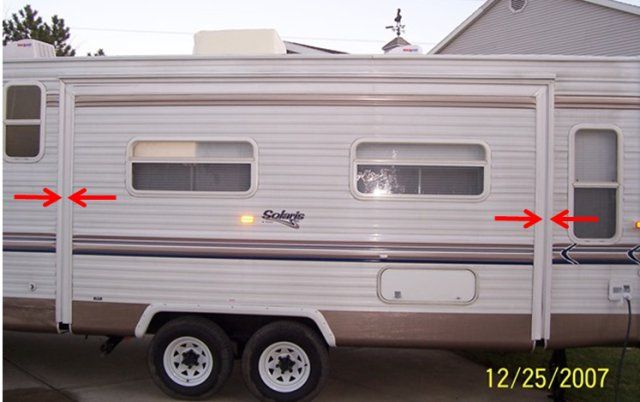
This is the lower flange behind the rear left frame hanger. Notice there is no distortion of the lower flange.
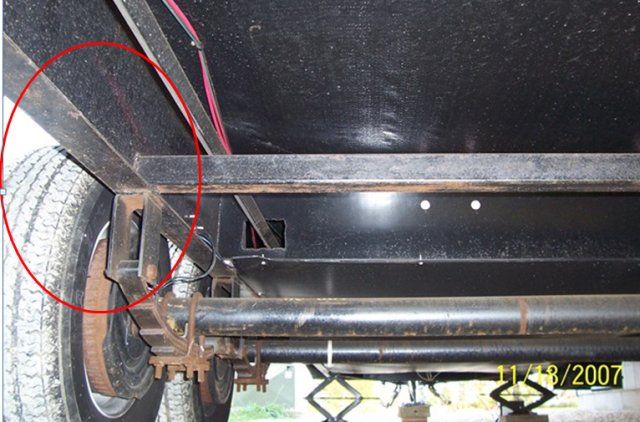
Now a few pics of time line leading up to current day. No damage yet in these pics.
2-8-2009 no damage
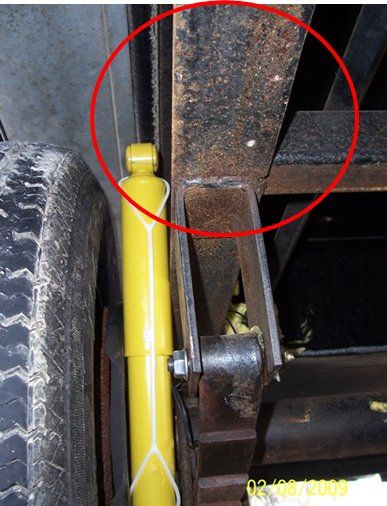
5-10-2009 adding reinforcement to prevent hanger flexing and lower flange bending and web cracking. No frame damage
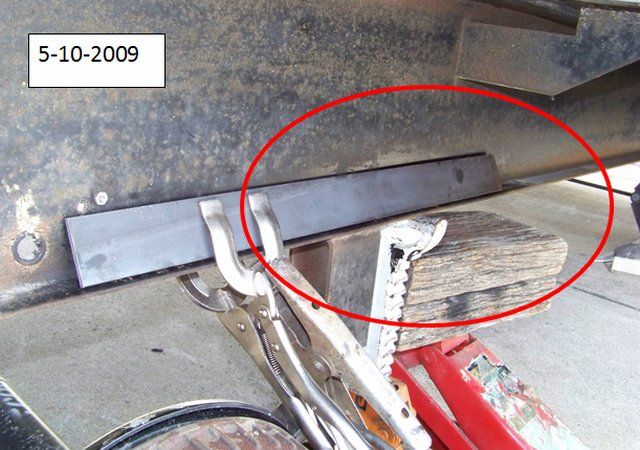
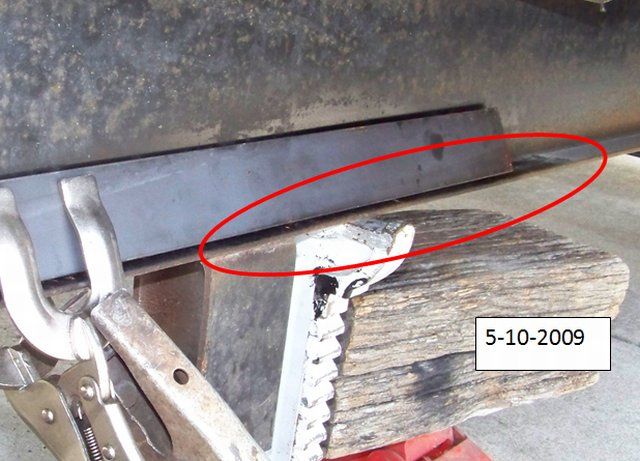
Now the start of damage. Picture taken on 12-11-2010 when adding rear shocks
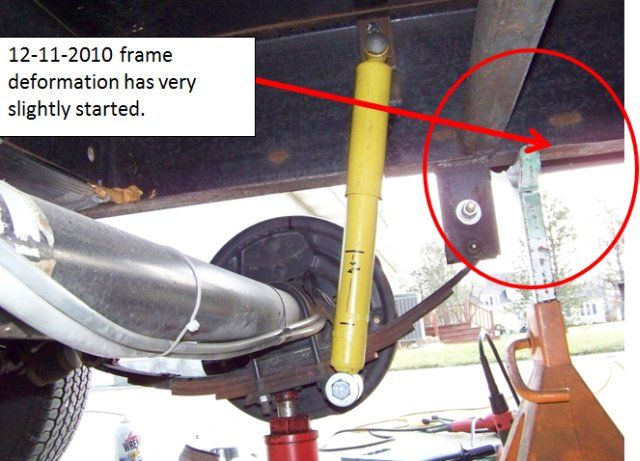
4-15-2012. Top rear of slide. Gap 3/4"
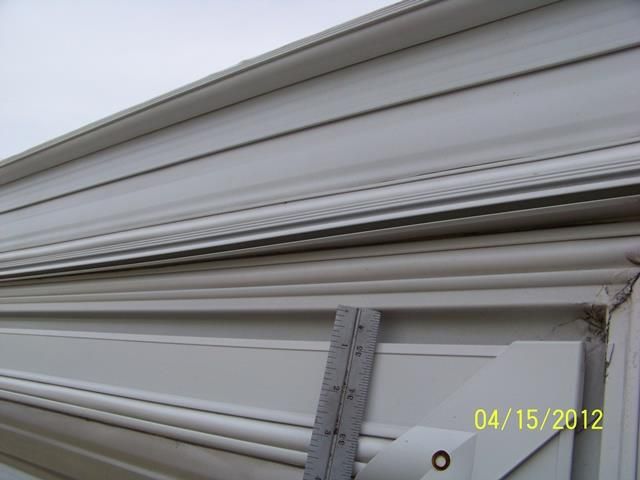
4-15-2012. Top front of slide. Gap 1 1/8" Must adjust slide arms to shift slide to fit camper hole better. This creates a situation inside were we do not lift off the carpet as much
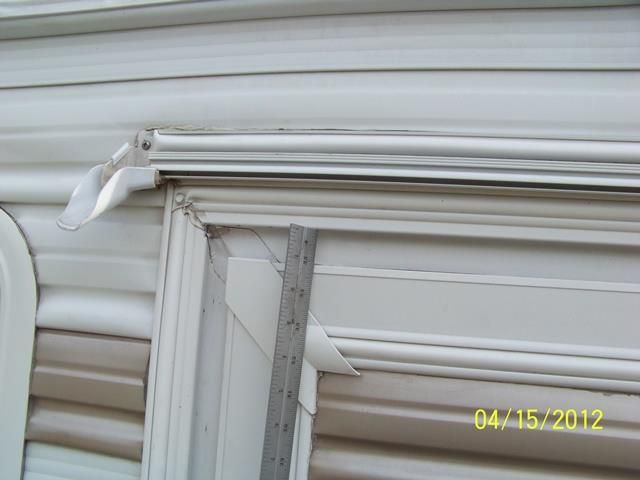
More on the next reply.
- Mark as New
- Bookmark
- Subscribe
- Mute
- Subscribe to RSS Feed
- Permalink
- Report Inappropriate Content
Oct-28-2017 03:00 PM
gbkim wrote:
Hi John,
I know it's been awhile since you fixed you frame.
I had a question about the steel used for the sister plates, gussets.
Do you buy the same 70ksi rated steel to match up with the frame's steel as well as the 7018C welding rod?
I often read where a steel reinforcement is welded on, but no mention about the type of steel.
Hi Gene,
On all the steel, I started hunting for A529-50 which is high strength low carbon steel which is 50ksi yield and 70-100ksi tensile. A529 I could not get short of a mill run.
I ordered A572-50 which is very similar. The mill supply house ended up substituting ASTM A1011-50 to fill the order. Which is very close as well. The mill certs on what I have tested out as 62ksi yield and 74.2ksi tensile. I bought a sheet 5 x 10ft and had it sheared, rolled to straighten and formed to what I wanted on the splice plates. The flat strips came out well with the rolled straightening.
I needed the 50ksi steel to get the strength I wanted in a thinner plate. Using 36ksi steel would of been too thick and the weight would of gone way up.
Welding, I use E7018AC for the uphill welding. It layed down smooth as expected. I had a limited amount of those rods as I did not have a way to pre condtion them at the temps needed. And buying a treating oven for this small job wasn't justified. I used E7014 which does not need the preconditioning on everything else.
Thanks
John
- Mark as New
- Bookmark
- Subscribe
- Mute
- Subscribe to RSS Feed
- Permalink
- Report Inappropriate Content
Oct-28-2017 07:40 AM
I know it's been awhile since you fixed you frame.
I had a question about the steel used for the sister plates, gussets.
Do you buy the same 70ksi rated steel to match up with the frame's steel as well as the 7018C welding rod?
I often read where a steel reinforcement is welded on, but no mention about the type of steel.
Any pictures of your repair?
Thanks
Gene
- Mark as New
- Bookmark
- Subscribe
- Mute
- Subscribe to RSS Feed
- Permalink
- Report Inappropriate Content
Apr-05-2017 04:27 PM
JBarca wrote:hawkeye-08 wrote:
Any updates on this? Did you complete repair?
Hi,
Any updates, I have not found in an online search any other frame damages like I have. I'm sure there are some, just not posted about.
Yes, I did complete the repair. It came out well but was time consuming and a good learning situation. The slide side of the frame is repaired and I am now finishing up correcting the damage done to the slide from being out of square and painting the rest of the camper frame. (It's a long... camper when it comes to scraping rust and painting the frame.)
Once I get that done, I have to turn the camper around in my shop and add some more lower flange reinforcement to the door side so that side of the camper is closer in strength to the now reinforced slide side. I did not want to have one very strong side and one weaker side. May get some strange twisting in a future pot hole bump situation.
The thread was originally about if anyone has seen this issue to gain more info about how the issue came about. Which other then what Doug posted on new campers, seems to be not as pronounced as other frame issues (A frame issues, bent hangers, cracked web from hanger flex etc. there is a lot out there)
Did you have any specific questions on the repair?
Thanks
John
Thanks for the update, I was just curious to hear how it turned out.
- Mark as New
- Bookmark
- Subscribe
- Mute
- Subscribe to RSS Feed
- Permalink
- Report Inappropriate Content
Apr-03-2017 07:20 PM
hawkeye-08 wrote:
Any updates on this? Did you complete repair?
Hi,
Any updates, I have not found in an online search any other frame damages like I have. I'm sure there are some, just not posted about.
Yes, I did complete the repair. It came out well but was time consuming and a good learning situation. The slide side of the frame is repaired and I am now finishing up correcting the damage done to the slide from being out of square and painting the rest of the camper frame. (It's a long... camper when it comes to scraping rust and painting the frame.)
Once I get that done, I have to turn the camper around in my shop and add some more lower flange reinforcement to the door side so that side of the camper is closer in strength to the now reinforced slide side. I did not want to have one very strong side and one weaker side. May get some strange twisting in a future pot hole bump situation.
The thread was originally about if anyone has seen this issue to gain more info about how the issue came about. Which other then what Doug posted on new campers, seems to be not as pronounced as other frame issues (A frame issues, bent hangers, cracked web from hanger flex etc. there is a lot out there)
Did you have any specific questions on the repair?
Thanks
John
- Mark as New
- Bookmark
- Subscribe
- Mute
- Subscribe to RSS Feed
- Permalink
- Report Inappropriate Content
Apr-03-2017 01:41 PM
- Mark as New
- Bookmark
- Subscribe
- Mute
- Subscribe to RSS Feed
- Permalink
- Report Inappropriate Content
Feb-07-2017 12:31 PM
JBarca wrote:
...From researching this, Artic Fox uses weld bead in the upper flange area to create camber in the frame behind the axles when new. They use to weld approx 2 to 3" weld bead on the top flange at an angle as they showed in their 2007 camper brochures. My buddies 2 year old Fox, has the weld bead on the inside radius of the upper flange. He can't tell if the bead is on top or not as the camper is sitting on it. They may have changed their methods. On his camper, this is only in the axle area on the upper flange.
I'm assuming they are using that heat shrink to force the frame rail upper flange into compression. Since the upper flange is in compression, it can take more stress as the top flange is normally in tension overhung off the back of the axles. You have to pull all that compression stress to zero before the tension starts, thus creating more beam holding power. I do not know this for fact, but I can see the science adding it to that it will work like that. Point is, they do this all the time and have learned the technique. And the fact there is no camper on top of the frame.
Give me a day or 2 and I'll have my plan up to see.
Thanks
John
The actual mechanics of what is happening is hard to explain but my understanding is the primary mechanism is volumetric change due to thermal expansion. When you apply a weld you are apply weld material along with a lot of localized heat, locally all of the material adjacent to the weld attempts to expand. This expansion is constrained by the adjacent unheated material, in the simplified case of a beam, the heated side needs to expand in volume but the unheated side is resisting this expansion. This results in the wall of the material expanding tangentially and not longitudinally. When the beam cools, the opposite occurs but due to the time duration and way the stresses redistribute, the material at the heated then cooled section will now be physically slightly thicker and slightly shorter. This will result in a net camber/distortion due to the material at the top pulling the bottom into tension. Sorry for the side track as this doesn't address you issue at hand.
I wish I could spend more time looking at your issue but quickly looking thru your pictures it appears you may want to look into verifying if you have a local buckling of the flange problem. This would show up in places of high moment (bottom flange adjacent to the rear spring hanger at the rear cantilever) or wherever the flange has be impacted or distorted due to jacking.
The typical strength failure mode of slender I type sections is local in nature. Looking at a section subject primarily to moment, it is going to be the flange in compression buckling causing overall flexural failure. So, whatever fix you end up coming up with make sure to straighten any of the distorted flanges and brace appropriately.
Also, I find when looking at fixes I always try to keep in mind that deflection and strength, although related, are issues that need to be addressed separately. You may want to step back and determine if you have a lack of strength issue or a stiffness (deflection) problem.
2013 AF 811
2004 Jeep TJ (slightly modded)
18' PJ Buggy Hauler
- Mark as New
- Bookmark
- Subscribe
- Mute
- Subscribe to RSS Feed
- Permalink
- Report Inappropriate Content
Feb-06-2017 08:20 PM
pickjare wrote:
It seems like you have a very good method in mind to resolve this. One thing that I want to add is consider moving the rear axle back 6", hangers and all. Distribute that load over a longer section of the frame opposite of how a teeter totter holds a load. Perhaps moving the axle back along with the method you are already getting set to do.
Hi,
Thanks for your reply. All ideas welcome even if I do not use all parts of them, they help spur other ideas. I agree if the rear hanger was back 6" after a repair, it could help. Thinking through moving the axles back 6" is an "amount" of work including the fenders on the camper. The 6" back movement also adds some level more loaded tongue weight. This rear living floor plan already has a 1,600# loaded TW. The added TW may not be much but not to be lost sight of. I'll keep this in mind as I work through this.
Thanks again
John
- Mark as New
- Bookmark
- Subscribe
- Mute
- Subscribe to RSS Feed
- Permalink
- Report Inappropriate Content
Feb-06-2017 08:13 PM
Jframpey wrote:
I'm an amateur and metal work and welding but why not sister an L angle along side and under the original frame, weld the axle hangers to that? Use the biggest possible and extend it forward and back of the original point of bending.
Thanks for the reply and thoughts. I use bits and pieces of all ideas as I can. Ideally added reinforcement is added to maintain the I beams center balanced loading about the beams neutral axis (center of the I beam vertically and horizontally). Having a large vertical angle leg off center and not attached to the top flange along with the vertical leg out on the very edge of the lower flange is not a balanced loading. This angle iron method if I'm envisioning your thoughts right, would need more thought on how that off center loading will affect the original I beam.
Thanks
John
- Mark as New
- Bookmark
- Subscribe
- Mute
- Subscribe to RSS Feed
- Permalink
- Report Inappropriate Content
Feb-06-2017 07:57 PM
dougrainer wrote:
No, not that one. There are 2 sheets. The 0104 and the 0135 rev A that address your issue. Doug
Hi Doug,
I found 0135 Rev A on line, this one. Deals with flexing spring hangers. this one Reparing frame cracks in axle location
On that one, I addressed the hanger flex a while ago. See here, TT Spring Hanger Stiffening (Long, lots of pics)
I added gusset reinforcement on the lower frame flange to the web and put 2" black iron pipe between the hangers and beefed up the long 5" hanger on all hangers to stop the flexing. So on this issue, I'm good unless you where meaning something else on that 0135 LIP sheet?.
Yesterday after thinking about this from what the Lip Sheet 068 said about measuring for camber, I went out and measured the frame differently then I had before and learned some new things. The frame at the axle area from front spring hanger to rear spring hanger is true straight which I did know. It is bent just aft of the rear spring hanger. I took a line starting about 1 foot forward of the front spring hanger and went all the way to the end of the frame. That is a 169" long string pulled with 66" of it over the axle area so it was a good long established straight line over the axles and 103” over the frame rail behind the rear axle hanger.
I moved the line to be dead on straight with the frame at the axle area and then could see the frame bending down past the last hanger. See here:
The setup
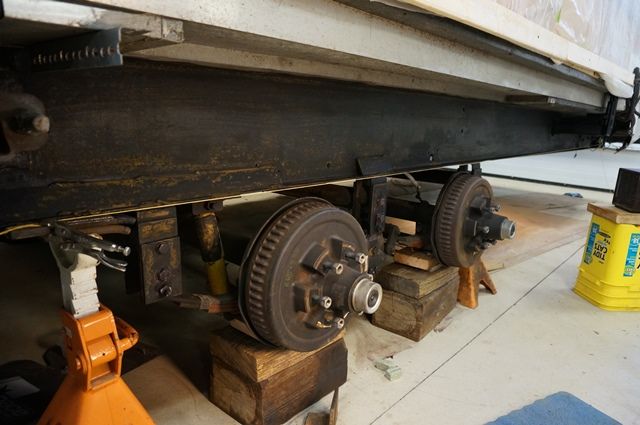
Eyeing down the frame, you can see it drop down past the rear hanger
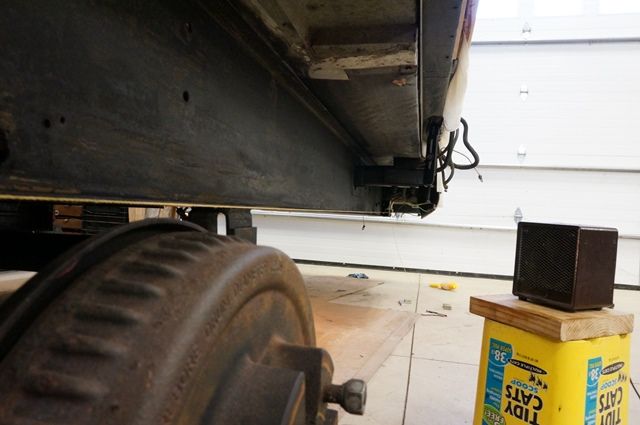
1 3/16" difference at the end of the main frame.
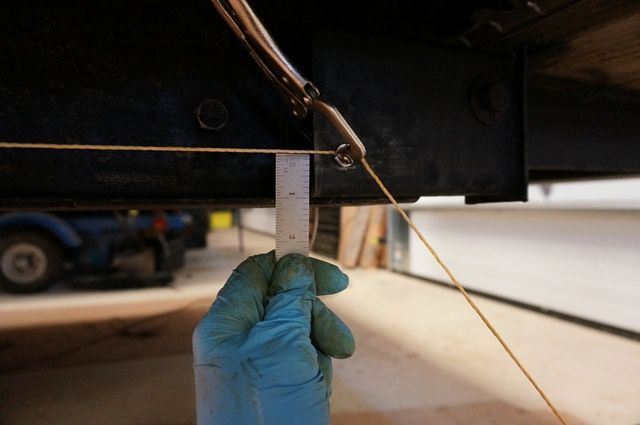
At the end of the frame, it is 1 3/16" lower, bottom of frame to line. But I also measured every 12" along the frame rail starting at the bend area to the end of frame. The distance is the same once past the bend area. 1/8" per foot. This helps shows the frame rail straight once past the bend area.
This 1 3/16" frame sag is a different way of looking at this. Thanks for pointing me this way. When I jacked the end of the frame up 3" on the end of the frame, the whole frame came straight. The weight of the camper pushing down on the frame rail helped force it straight while the jack is putting point load on the end of the frame. That is a key understanding in this different way to measure what it takes to create a straight frame rail and helped me with the LCI call today. I could tell them how much it is bent in it's current state and how much lift and force to create a straight rail again.
I called LCI tech service today and explained my situation and what could they offer as a repair. It was a really good call and I felt the guy in chassis tech service had been around a while by the conversion. I asked about the method they would use on how they would fix this and if I can hire their mobile crew.
On the fix, he asked if I could jack the frame straight. I told him I could. It takes 2,300# of lift force and 3" of lift at the back of the camper to bring the frame rail back to straight. But I'm also lifting a good amount of the camper off the ground while I'm doing this as shown by the tire contact patch changing so much. I'm almost having the rear tire lift off.
He said that is part of what they would do. They would jack the frame back to straight and then weld on reinforcements on the bottom flange to hold it in place. They may go a little higher lift to create some excess lift so when they lower the camper any frame flex will be closer to where it needs to be. I asked, what about all that beam stress built up from the original bend and now this 2,300# of up loading adds more bending stress? He said, that is a risk and they would not know if that is a problem or not.
I asked on the mobile crew cost and I understand what field service rates are. It is about 6 hours from Elkhart to my area and the field team most likely would come from there. He did not know the rates and switched me to the field service group. I was going to ask them the same questions on how they would do the repair and an estimation on the cost. I have 2 calls/voice mails into the service lady and she has not got back to me yet. Don't know if she is out or in non stop phone calls. So at this point, I'm waiting for the field service group to call me back.
Do you know what LCI did on the warranty jobs you have seen to get the frame back straight? Are they using weld shrink to try and pull it back, or jacking or some combo there of? I assume they used what method they can pending the situation. In my case, if just jacking the back up and adding steel to hold it straight is their fix, I myself can do that but that is a concern for me for the long haul with all that trapped bending stress and I need the frame to be stronger then original so I do not have this happen again. I have to think through their approach real good and make sure it would be what I want if I go with them. I'm hoping the field service group can give me some more reassurance that having that large of a trapped stress in the frame rail will not create problems down the road. I'm seeing I have to deal with it.
Thanks
John
- Mark as New
- Bookmark
- Subscribe
- Mute
- Subscribe to RSS Feed
- Permalink
- Report Inappropriate Content
Feb-05-2017 07:23 PM
- Mark as New
- Bookmark
- Subscribe
- Mute
- Subscribe to RSS Feed
- Permalink
- Report Inappropriate Content
Feb-05-2017 06:24 PM
Thanks for the reply. The frame rail is a thin I beam shape. Actually more like a W shape but I do not want to even give the hint it is in the class of a W shape. They are also known as MH beams ( manufactured home beam) They have very thin top and bottom flanges and they are parallel. The web and flanges are 0.168" thick. Mine is known as a 10" x 9 lb/ft thin I beam.
I understand your thoughts as they pertain to a channel.
Thanks
John
- Mark as New
- Bookmark
- Subscribe
- Mute
- Subscribe to RSS Feed
- Permalink
- Report Inappropriate Content
Feb-05-2017 06:19 PM
- Mark as New
- Bookmark
- Subscribe
- Mute
- Subscribe to RSS Feed
- Permalink
- Report Inappropriate Content
Feb-05-2017 04:04 PM
- Mark as New
- Bookmark
- Subscribe
- Mute
- Subscribe to RSS Feed
- Permalink
- Report Inappropriate Content
Feb-05-2017 09:20 AM
Huntindog wrote:
I am very glad that my manufacturer spec'd a heavy duty Lippert frame.
If anyone here can do the fix, you are the one.
I agree that trying to jack it back into place will likely damage other areas....
The only way I can think of fixing this would be to raise the box off of the frame.... That is a HUGE undertaking, and will need some thinking outside the box to accomplish.
I am interested in how Lippert would fix it, and what your plan of attack is.
The suspense is killing me...
Seriously, I am sorry that you are facing this issue. No one should have to face this sort problem.
Hi Huntingdog,
Thanks for the good words. Yeh, I'm sorry too I'm facing this, but I've got it now and we will get it fixed and learn from it.
That I-88 in NY was brutal with potholes. That is not a normal situation, man I hope not... but it shows that these RV frames are right on the edge of what can come at you on the road.
There is a big learning for me to on how the frame can fail. If I would of known what to look for on the lower flange for being bent "after" that event, this would a been a lot easier fix then I have now. Once the lower flange is compromised that beam structure is no where as strong. And over normal towing afterwords with all the usual frame flex that happens, it just kept ratcheting down.
We'll get it. And come spring be back out camping.
Thanks
John





